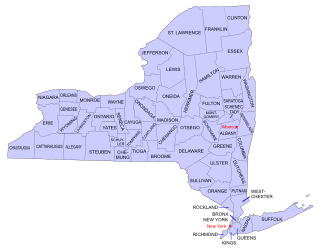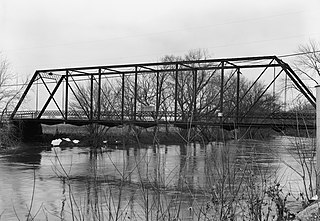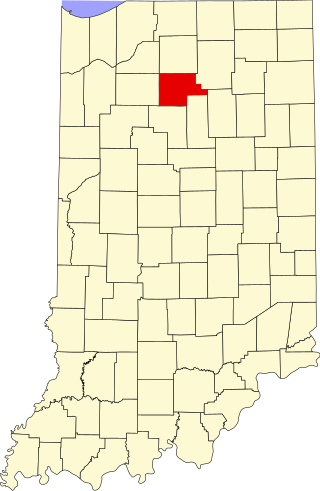
U.S. Route 45 is a major north-south United States highway and a border-to-border route, from Lake Superior to the Gulf of Mexico. A sign at the highway's northern terminus notes the total distance as 1,297 miles (2,087 km).

The Bridal Veil Falls is a waterfall located on Bridal Veil Creek along the Columbia River Gorge in Multnomah County, Oregon, United States. The waterfall is accessible from the historic Columbia River Highway and Interstate 84. Spanning two tiers on basalt cliffs, it is the only waterfall which occurs below the historic Columbia Gorge Scenic Highway. The Bridal Veil Falls Bridge, built in 1914, crosses over the falls, and is listed on the National Register of Historic Places.

Buildings, sites, districts, and objects in New York listed on the National Register of Historic Places:
The Illinois Historic Preservation Division, formerly Illinois Historic Preservation Agency, is a governmental agency of the U.S. state of Illinois, and is a division of the Illinois Department of Natural Resources. It is tasked with the duty of maintaining State-owned historic sites, and maximizing their educational and recreational value to visitors or on-line users. In addition, it manages the process for applications within the state for additions to the National Register of Historic Places and other federal preservation schemes.

U.S. Route 66 was a United States Numbered Highway in Illinois that connected St. Louis, Missouri, and Chicago, Illinois. The historic Route 66, the Mother Road or Main Street of America, took long distance automobile travelers from Chicago to Southern California. The highway had previously been Illinois Route 4 and the road has now been largely replaced with Interstate 55 (I-55). Parts of the road still carry traffic and six separate portions of the roadbed have been listed on the National Register of Historic Places.
The Duncan Mills Bridge was one of nine metal highway bridges in Fulton County, Illinois nominated for the National Register of Historic Places. This particular one was located along west of Havana, Illinois near Lewistown. It was added to the National Register of Historic Places on October 29, 1980, along with the seven of the eight other bridges, as one of the "Metal Highway Bridges of Fulton County". Some of the other bridges include the now demolished Buckeye Bridge and the Tartar's Ferry Bridge, both near Smithfield.

The Indian Ford Bridge was one of nine metal highway bridges in Fulton County, Illinois listed on the National Register of Historic Places. This particular one was located along County Highway 20 as spans the Spoon River, 1.5 miles (2.4 km) southwest of London Mills. It was added to the National Register of Historic Places on October 29, 1980, along with the eight other bridges, as one of the "Metal Highway Bridges of Fulton County." Some of the other bridges included London Mill's only other Registered Historic Place, the now demolished London Mills Bridge. Other demolished bridges include the Elrod Bridge, Duncan Mills Bridge and Buckeye Bridge.

The London Mills Bridge was one of nine metal highway bridges in Fulton County, Illinois listed on the National Register of Historic Places. This particular one was located along County Highway 39 as it spans the Spoon River on the north side of London Mills. It was added to the National Register of Historic Places on October 29, 1980, along with the eight other bridges, as one of the "Metal Highway Bridges of Fulton County". Some of the other bridges included London Mill's only other Registered Historic Place, the Indian Ford Bridge.

The Seville Bridge is one of nine metal highway bridges in Fulton County, Illinois that were listed on the National Register of Historic Places. This particular one is located across the Spoon River in Seville. It was added to the National Register of Historic Places on October 29, 1980, along with the eight other bridges, as one of the "Metal Highway Bridges of Fulton County. Some of the other bridges include the Buckeye Bridge, Tartar's Ferry Bridge and the Bernadotte Bridge, all in Smithfield. Five of the nine bridges have been demolished, though Seville Bridge still stands.

The Bernadotte Bridge at Bernadotte, built in 1910, is one of nine metal highway bridges in Fulton County, Illinois listed on the National Register of Historic Places. The bridge is located along County Route 2 between Smithfield, Illinois to the north, and Ipava, Illinois to the south. It was added to the National Register of Historic Places on October 29, 1980, along with the eight other bridges, as one of the "Metal Highway Bridges of Fulton County". The bridge is one of three near Smithfield listed on the Register, the others are the Buckeye Bridge and the Tartar's Ferry Bridge. A fourth bridge near the Smithfield was included on the Register but removed in 1996, following its 1995 destruction.

Buckeye Bridge also known as White's Ferry Bridge was one of nine metal highway bridges in Fulton County, Illinois once listed on the National Register of Historic Places. Buckeye is one of the five bridges that have been demolished out of nine similar bridges in the county. This particular one was over the Spoon River near Smithfield, Illinois. It was added to the National Register of Historic Places on October 29, 1980, along with the eight other bridges, as one of the "Metal Highway Bridges of Fulton County". The bridge was one of three near Smithfield listed on the Register, the others are the Bernadotte Bridge and the Tartar's Ferry Bridge. Others, such as the Babylon Bend Bridge in Ellisville, are located throughout the county. Another Smithfield area bridge, Elrod Bridge, was nominated with the original Multiple Property Submission but removed from the Register after its 1995 destruction by an F-4 tornado.

Tarter's Ferry Bridge was one of nine metal highway bridges in Fulton County, Illinois listed on the National Register of Historic Places. This particular one was a 9-panel Parker through truss that carried Tarter Ferry Road over the Spoon River near Smithfield, Illinois. It was added to the National Register of Historic Places on October 29, 1980, along with the eight other bridges, as one of the "Metal Highway Bridges of Fulton County. The bridge was one of three in Smithfield listed on the Register, the others are the Bernadotte Bridge and the destroyed Buckeye Bridge, as well as the demolished Elrod Bridge. Others, such as the Duncan Mills Bridge in Lewistown, are located throughout the county.

The Metal Highway Bridges of Fulton County Thematic Resources is the title for a Multiple Property Submission to the National Register of Historic Places in the U.S. state of Illinois. Originally the submission included nine separate bridges throughout Fulton County; however, since the Metal Highway Bridges' inclusion on the Register in 1980, more than half of those bridges have been destroyed.
Elrod Bridge was one of nine metal highway bridges in Fulton County, Illinois once listed on the National Register of Historic Places. It was listed from 1980 until 1995.

Millville is a defunct settlement in Jo Daviess County, Illinois, United States, located within the boundaries of Apple River Canyon State Park. Founded in 1835 and platted in 1846, the community was washed away completely by a flood in 1892. No visible remnants of its structures remain today. The site of Millville was added to the U.S. National Register of Historic Places as the Millville Town Site in 2003.

This is a list of the National Register of Historic Places listings in Fulton County, Indiana.

McNutt Rural Historic District is located in Rapides Parish, Louisiana around the intersection of Belgard Bend Rd. and Louisiana Highway 121 that make up the rural community of McNutt, Louisiana. It was added to the National Register of Historic Places on September 15, 1988. McNutt is named from "McNutt Hill," itself named for Isaac McNut], the son-in-law of John Texada, a federal land agent in the area in the early 1800s.

The Highway B-29 Bridge is a historic bridge in Prairie Grove, Arkansas. It is a single-span concrete arch bridge, carrying Washington County Route 623 across the Illinois River. The arch has a span of 97 feet (30 m), and the total structure length is 100 feet (30 m). Its deck is 17 feet (5.2 m) wide, and the bridge is typically 20 feet (6.1 m) above the water. Built in 1923, the bridge is one of the first built in the county by the Luten Bridge Company, which used an innovative technique involving metal rings that reduced the amount of material required for the structure.

The Martin's Mill Covered Bridge is a wooden covered bridge spanning Lull's Brook on Martinsville Road in Hartland, Vermont. Built about 1880, it is one of two surviving 19th-century covered bridges in the town. It was listed on the National Register of Historic Places in 1973.

The Columbia Historic District is a neighborhood in Cedarburg, Wisconsin, that is listed on the National Register of Historic Places. At the time the district was listed on the register, its contributing properties included 128 historic homes, one church, and eighty-seven historic outbuildings, including garages and barns, all constructed between 1844 and 1938. The district also contained several dozen buildings that do not contribute to the historic district, including modern homes from the post-war era as well as modern garages and other additions to historic properties.

















